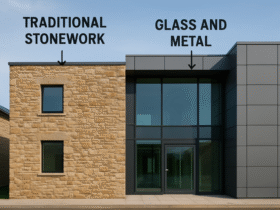Choosing the right flooring is one of the biggest design decisions you’ll make in your home. It influences how the space looks, feels, and functions. It also plays a major role in your daily comfort, long-term maintenance, and even the value of your home.
The trouble is, there’s no one-size-fits-all answer. What works beautifully in a formal dining room might be completely impractical in a busy mudroom. Add in the wide range of styles, materials, and prices, and it’s no surprise that flooring decisions can feel overwhelming.
Here’s how to cut through the noise and choose flooring that fits your space, your lifestyle, and your priorities.
Start With the Space Itself
Before thinking about color or material, consider the function of the room. Every area in your home has different needs when it comes to flooring.
Ask yourself:
How much foot traffic does this room get?
Will it be exposed to moisture, spills, or pets?
Do you want it to feel cozy, practical, luxurious, or low maintenance?
For example, bedrooms are all about comfort underfoot. Softness, warmth, and quiet are key. Kitchens and bathrooms, on the other hand, deal with water, mess, and constant traffic, so durability and water resistance become the top priority.
Understand the Main Types of Flooring
There are five main categories most homeowners consider. Each has its strengths, and the right one depends on how you plan to use it.
1. Hardwood Flooring
Hardwood is classic, warm, and timeless. It adds resale value and ages well if maintained properly. But it can be vulnerable to water and scratching, especially in homes with pets or kids.
Best for: Living rooms, bedrooms, dining areas
Less ideal for: Bathrooms, laundry rooms, basements
2. Laminate Flooring
Laminate mimics the look of hardwood or stone but at a lower cost. It’s scratch-resistant, easy to clean, and holds up well to everyday wear. However, it doesn’t handle water as well as other options.
Best for: Hallways, living rooms, home offices
Less ideal for: Areas with frequent moisture
3. Vinyl Flooring
Vinyl has come a long way. It’s now available in a wide range of realistic finishes and is incredibly durable and waterproof. It’s also softer and warmer underfoot than tile or stone.
Best for: Kitchens, bathrooms, mudrooms, basements
Less ideal for: Formal or high-end areas
4. Tile Flooring
Tile offers unmatched water resistance and design variety. It can handle spills, humidity, and heat without damage. However, it’s cold underfoot and can be hard on your joints if you stand on it for long.
Best for: Bathrooms, kitchens, laundry areas
Less ideal for: Bedrooms, family rooms
5. Carpet
Carpet adds warmth, comfort, and sound insulation. It’s ideal for low-moisture spaces where comfort is key. But it does require more upkeep and isn’t a great match for pets or allergies.
Best for: Bedrooms, playrooms, low-traffic areas
Less ideal for: Entryways, kitchens, bathrooms
Think About Lifestyle
Every home is different. A family with young kids will need something entirely different from a quiet couple or someone living alone.
Consider these factors:
- Pets – Claws, accidents, and shedding mean you’ll want something scratch-resistant and easy to clean.
- Kids – Spills and rough play call for durability and low maintenance.
- Noise – Multi-level homes or apartments benefit from floors that absorb sound, like carpet or cork.
- Allergies – Smooth surfaces are easier to keep dust-free than carpet.
If your household is busy, go for tough and easy-to-clean flooring Buford GA. If you live in a quieter space, you might have more flexibility and can focus more on appearance or comfort.
Balance Style With Practicality
Flooring has a major visual impact. It sets the tone for the entire room. That said, it shouldn’t come at the cost of functionality.
Here are some style tips to keep in mind:
- Light floors – Make spaces feel airy and larger, but may show dirt more easily.
- Dark floors – Add drama and warmth, though they can make small rooms feel tighter.
- Wide planks – Create a modern, clean look and make rooms feel more open.
- Patterned tile – Works well in small spaces or as an accent, but may overwhelm larger areas.
If you’re planning to sell your home in the near future, stick with neutral, timeless options. These tend to appeal to more buyers and suit a wider range of styles.
Don’t Forget Comfort and Temperature
Some materials feel cold underfoot, while others offer warmth and softness. This makes a big difference in places where you walk barefoot, like bedrooms and bathrooms.
Here’s a quick comparison:
- Warm and soft – Carpet, cork, vinyl
- Cool and hard – Tile, stone
- Middle ground – Hardwood, laminate (especially with underlayment)
If comfort is a top priority, especially in places like nurseries or bedrooms, you might even want to layer area rugs over a harder floor.
Plan for Maintenance
Some floors are low maintenance, others demand regular care. Think about how much time and energy you realistically want to spend on cleaning and upkeep.
High-maintenance options:
- Natural stone that needs sealing
- Hardwood that requires refinishing
Low-maintenance options:
- Vinyl
- Laminate
- Ceramic tile
Also think about repairability. Can scratches be buffed out? Can a damaged section be replaced without ripping out the whole floor?
Keep Budget in Check
Flooring can get expensive quickly, especially across large areas. Costs include not just the material but also installation, removal of old flooring, and underlayment if needed.
Here’s a simple breakdown of budget-friendly to premium:
- More affordable – Carpet, laminate, standard vinyl
- Mid-range – Engineered wood, luxury vinyl, basic tile
- High-end – Solid hardwood, natural stone, high-design tile
Always factor in labor costs, especially for tile or hardwood, where installation can be intensive.
Match Flooring Across Spaces
While every room doesn’t need the same floor, try to create visual flow between rooms. Too many materials in one home can feel disjointed. Ideally, aim for consistency across open spaces and main living areas.
In multi-floor homes, you can play with different materials upstairs and downstairs as long as the transition feels natural.
Quick Recap: What to Ask Before You Choose
Here’s a final checklist to run through:
What’s the room used for?
Will it get wet or dirty often?
How much foot traffic will it see?
Do you have pets or kids?
Do you want something soft or hard underfoot?
What’s your style — modern, rustic, traditional?
How much do you want to spend?
How much maintenance are you willing to do?
Answering these will help you narrow your choices and make a decision that feels right for your home, not just for right now, but for years ahead.
Where Form Meets Function
Flooring isn’t just a finishing touch — it’s the foundation of every room. The right choice will support your lifestyle, hold up to your day-to-day, and tie the whole space together. Start with how you live, what the room needs, and how you want it to feel. Once those pieces are clear, the right flooring choice often reveals itself.







